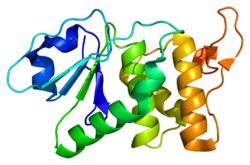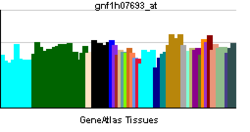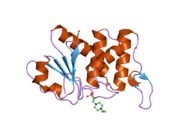- DUSP18
-
Dual specificity phosphatase 18 
PDB rendering based on 2esb.Available structures PDB 2esb Identifiers Symbols DUSP18; DSP18; DUSP20; LMWDSP20; MGC32658; bK963H5.1 External IDs OMIM: 611446 MGI: 1922469 HomoloGene: 34984 GeneCards: DUSP18 Gene Gene Ontology Molecular function • protein tyrosine phosphatase activity
• protein tyrosine/serine/threonine phosphatase activity
• hydrolase activity
• MAP kinase tyrosine/serine/threonine phosphatase activityCellular component • nucleus
• cytoplasmBiological process • peptidyl-tyrosine dephosphorylation Sources: Amigo / QuickGO RNA expression pattern 
More reference expression data Orthologs Species Human Mouse Entrez 150290 75219 Ensembl ENSG00000167065 ENSMUSG00000047205 UniProt Q8NEJ0 Q8BWD7 RefSeq (mRNA) NM_152511 NM_173745.5 RefSeq (protein) NP_689724 NP_776106.1 Location (UCSC) Chr 22:
31.05 – 31.06 MbChr 11:
3.8 – 3.8 MbPubMed search [1] [2] Dual specificity protein phosphatase 18 is an enzyme that in humans is encoded by the DUSP18 gene.[1][2]
References
- ^ Hood KL, Tobin JF, Yoon C (Oct 2002). "Identification and characterization of two novel low-molecular-weight dual specificity phosphatases". Biochem Biophys Res Commun 298 (4): 545–51. doi:10.1016/S0006-291X(02)02488-9. PMID 12408986.
- ^ "Entrez Gene: DUSP18 dual specificity phosphatase 18". http://www.ncbi.nlm.nih.gov/sites/entrez?Db=gene&Cmd=ShowDetailView&TermToSearch=150290.
Further reading
- Wu Q, Huang S, Sun Y, et al. (2006). "Dual specificity phosphotase 18, interacting with SAPK, dephosphorylates SAPK and inhibits SAPK/JNK signal pathway in vivo.". Front. Biosci. 11: 2714–24. doi:10.2741/2001. PMID 16720344.
- Jeong DG, Cho YH, Yoon TS, et al. (2006). "Structure of human DSP18, a member of the dual-specificity protein tyrosine phosphatase family.". Acta Crystallogr. D Biol. Crystallogr. 62 (Pt 6): 582–8. doi:10.1107/S0907444906010109. PMID 16699184.
- Gerhard DS, Wagner L, Feingold EA, et al. (2004). "The Status, Quality, and Expansion of the NIH Full-Length cDNA Project: The Mammalian Gene Collection (MGC)". Genome Res. 14 (10B): 2121–7. doi:10.1101/gr.2596504. PMC 528928. PMID 15489334. http://www.pubmedcentral.nih.gov/articlerender.fcgi?tool=pmcentrez&artid=528928.
- Collins JE, Wright CL, Edwards CA, et al. (2005). "A genome annotation-driven approach to cloning the human ORFeome". Genome Biol. 5 (10): R84. doi:10.1186/gb-2004-5-10-r84. PMC 545604. PMID 15461802. http://www.pubmedcentral.nih.gov/articlerender.fcgi?tool=pmcentrez&artid=545604.
- Ota T, Suzuki Y, Nishikawa T, et al. (2004). "Complete sequencing and characterization of 21,243 full-length human cDNAs". Nat. Genet. 36 (1): 40–5. doi:10.1038/ng1285. PMID 14702039.
- Wu Q, Gu S, Dai J, et al. (2003). "Molecular cloning and characterization of a novel dual-specificity phosphatase18 gene from human fetal brain". Biochim. Biophys. Acta 1625 (3): 296–304. PMID 12591617.
- Strausberg RL, Feingold EA, Grouse LH, et al. (2003). "Generation and initial analysis of more than 15,000 full-length human and mouse cDNA sequences". Proc. Natl. Acad. Sci. U.S.A. 99 (26): 16899–903. doi:10.1073/pnas.242603899. PMC 139241. PMID 12477932. http://www.pubmedcentral.nih.gov/articlerender.fcgi?tool=pmcentrez&artid=139241.
PDB gallery Esterase: protein tyrosine phosphatases (EC 3.1.3.48) Class I Classical PTPsReceptor type PTPs (PTPRA, PTPRB, PTPRC, PTPRD, PTPRE, PTPRF, PTPRG, PTPRH, PTPRJ, PTPRK, PTPRM, PTPRN, PTPRN2, PTPRO, PTPRQ, PTPRR, PTPRS, PTPRT, PTPRU, PTPRZ)
Non receptor type PTPs (PTPN1, PTPN2, PTPN3, PTPN4, PTPN5, PTPN6, PTPN7, PTPN9, PTPN11, PTPN12, PTPN13, PTPN14, PTPN18, PTPN20, PTPN21, PTPN22, PTPN23MAPK phosphatases (MKPs) (DUSP1, DUSP2, DUSP4, DUSP5, DUSP6, DUSP7, DUSP8, DUSP9, DUSP10, DUSP16, MK-STYX)
CDC14s (CDC14A, CDC14B, CDKN3, PTP9Q22)
Atypical DSPs (DUSP3, DUSP11, DUSP12, DUSP13A, DUSP13B, DUSP14, DUSP15, DUSP18, DUSP19, DUSP21, DUSP22, DUSP23, DUSP24, DUSP25, DUSP26, DUSP27, EMP2A, RNGTT, STYX)
Phosphatase and tensin homologs (PTENs) (PTEN, TPIP, TPTE, TNS, TENC1)
Myotubularins (MTM1, MTMR2, MTMR3, MTMR4, MTMR5, MTMR6, MTMR7, MTMR8, MTMR9, MTMR10, MTMR11, MTMR12, MTMR13, MTMR14, MTMR15)Class II Class III Class IV Categories:- Human proteins
- Chromosome 22 gene stubs
Wikimedia Foundation. 2010.

